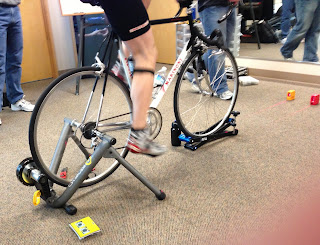Wednesday, March 27, 2013
Friday, March 22, 2013
OSR Physical Therapy Bike Fit
With the snow melting in MN, it is time for bike season. Let our Bike Fit professionals help you with injury prevention and bike fitting for racing, road biking, and recreation.
Here are some tips from the American Physical Therapy Association to help you get started:
Interested in injury prevention activities and bike fitting at OSR Physical Therapy? Contact Stephanie at stephanie.winters@osrpt.com or Rusty at rusty.wallman@osrpt.com for more information.
Here are some tips from the American Physical Therapy Association to help you get started:
Interested in injury prevention activities and bike fitting at OSR Physical Therapy? Contact Stephanie at stephanie.winters@osrpt.com or Rusty at rusty.wallman@osrpt.com for more information.
Monday, March 11, 2013
The importance of staying hydrated with activity
Water, roughly between 60-70% of what comprises you and I, plays a vital role in the functioning of everyday life. From better overall health to improved body temperature regulation, increased body lubrication and even improved weight maintenance, you will reap greater benefits if you stay well hydrated with water or water-rich fluids.
Hydration is vital to a successful athletic performance. When there is a lack of hydration, from the food you eat to beverages you drink, you will end up dehydrated. This commonly leads to fatigue; muscle cramping and even can reduce your coordination. It also compromises the body’s ability to cool itself through sweating which can also lead to dizziness, fatigue or even heatstroke.
When the difference between top finishers in an endurance event is only a few seconds or less, athletes can’t afford to loose time to dehydration. Athletes should pay close attention to fueling their bodies with fluids and foods consistently by finding their individual sweat rates.” This consists of weighing yourself before and after an athletic event to see how much body weight was lost due to hydration loss.
When you know how much fluid was lost by an athletic event, and then take the next step to learn how to ingest this amount during training, fluid consumption becomes much more automatic and the chance for dehydration during a time of importance (such as a competition) diminishes significantly.
Research suggests that 20-24oz of fluid needs to be consumed for each pound of body weight lost. For athletes who opt for endurance events, make sure to consume a sports drink that has both carbohydrates and an adequate amount of electrolytes by searching for drinks that have 200mg of sodium per 8oz of fluid.
For more information on hydration and athletic performance you can check out the position statement by the NATA.
http://www.ncbi.nlm.nih.gov/pmc/articles/PMC1323420/
Thursday, March 7, 2013
March: National Athletic Training Month
National Athletic Training
Month
“Every Body Needs an
Athletic Trainer”
March is National Athletic Training Month. Athletic
trainers utilize this opportunity to educate the public about their profession
and what exactly they do as certified athletic trainers.
Athletic trainer
not trainer
Athletic trainers, ATs, are health care professionals
that work under the direction of a physician according to their state
license. ATs are not personal or fitness trainers and do not train people for
the sole purpose of fitness and/or weight loss. Athletic training involves the
prevention, evaluation and diagnosis, immediate and emergency care, treatment
and rehabilitation, and organizational and professional health and well-being
of physically active people.
Education
An athletic trainer must obtain a bachelor’s or master’s
degree from an accredited program and pass a board of certification exam before
beginning practice. Athletic trainers must also maintain their knowledge and
skill by participating in continuing education, approximately 25 hours a year.
Not all athletes
wear jerseys
Athletic trainers work with a variety of patients and in
many different settings. Some of these setting include:
·
Physician extender
·
Performing arts
·
Clinics and hospitals
·
Law enforcement
·
Military
·
High schools, colleges and universities
·
Professional and Olympic sports
·
Industrial
In the video below a collection of surgeons, athletic
directors, and physicians tell why an athletic trainer is critical to keeping
physically active people safe.
Unsung Heroes of Sports Medicine on NATA page
Associations and
publications
The National Athletic Trainers’ Association, NATA, is the
professional membership association for athletic training and has over 35,000
members strong. These members are certified athletic trainers and other
professional who help support the profession. The NATA has established a
professional code of ethics that athletic trainers must abide by.
The Journal of Athletic Training publishes cutting edge
research to allow for health care professionals to continue growing in their
practice. The Journal of Athletic Training is among the top five sport science
journals offering tremendous impact and influence to the world of sports
medicine.
For more information please visit the following websites:
www.nata.org
(Informational materials tab)
www.bocatc.org
(Public tab)
Subscribe to:
Comments (Atom)






